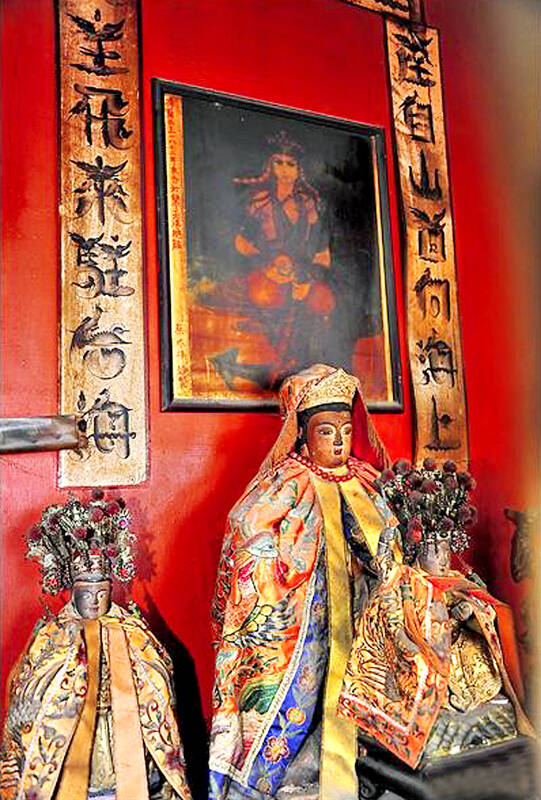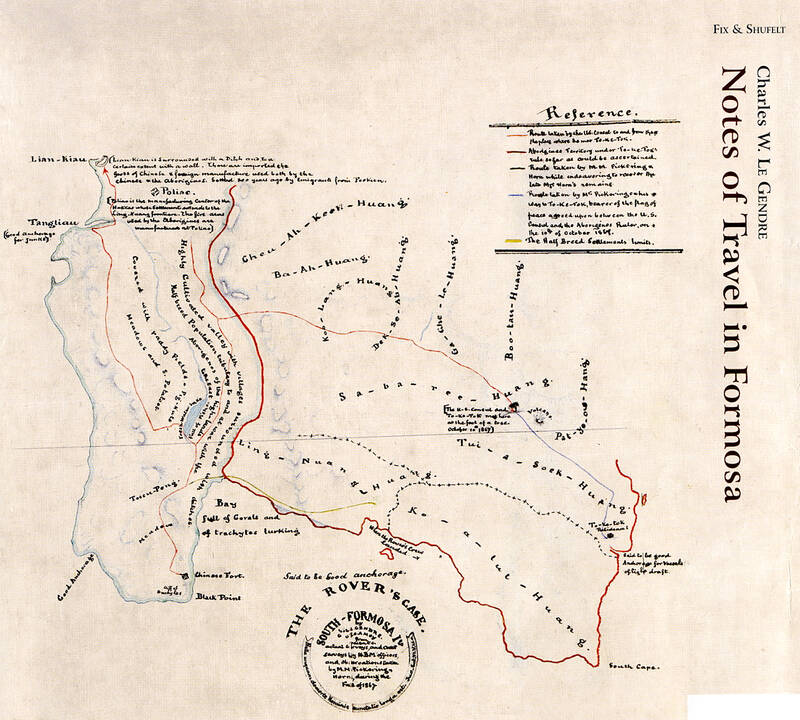March 11 to March 17
The 1894 Hengchun County Annals (恆春縣志) contains a tale about a “foreign ship” that drifted aground in today’s Kenting area. Indigenous warriors spotted the vessel and killed the entire crew, which included a “barbarian (foreign) woman” who was a princess in her homeland.
The account states that this incident occurred during the Qing Dynasty’s Tongzhi era (1862-1875), and indeed on March 12, 1867, the same fate befell the crew of the American merchant ship Rover, which was shipwrecked in the same area. However, the only woman on board, Mercy G. Hunt, wife of captain Joseph Hunt, was no princess.

Photo: Tsai Tsung-hsien, Taipei Times
Adding to the intrigue is the nearby Wanyinggong Temple (萬應公祠), which contains a shrine dedicated to Princess Babao (八寶, eight treasures), a Dutch royal who was killed along with her crew during Dutch rule of southern Taiwan — more than 200 years before the Rover Incident.
The human remains worshiped in the shrine were found by locals by the beach in 1931 and according to temple legend, a spirit medium later revealed her identity as a Dutch princess. She wished to remain in Taiwan. To avoid calamity, the spirit medium instructed worshipers to allocate one-third of the temple’s space to the princess and give her a separate altar.
Many argue that the “princess” was actually Mercy G. Hunt, and that the truth was distorted as the story spread in the region. National Museum of Taiwan History researcher Shih Wen-cheng (石文誠) supports this argument in the 2009 study “Did a Dutch princess come ashore? How history and memories intersect” (荷蘭公主上了岸?一段傳說、歷史與記憶的交錯歷程).

Photo: Tsai Tsung-hsien, Taipei Times
Chen Yao-chang (陳耀昌), author of the 2016 novel Puppet Flower (傀儡花), which revolved around the Rover Incident, also noticed the similarities between the two stories when doing research. At the 2018 press conference announcing the adaptation of his book into the drama series Seqalu: Formosa 1867 (斯卡羅), he expressed his wishes for the temple to rectify its error and honor Mercy G. Hunt instead.
WORSHIPPING HUMAN REMAINS
The veneration of human remains found at sea was common in fishing societies across Taiwan. For example, the Aug. 6, last year edition of “Taiwan in Time” details the story of Hongmaogang Village’s Baoan Temple (保安宮), which worships a skull that allegedly belongs to the commander of a Japanese warship that sank during World War II.

Photo courtesy of Wikimedia Commons
The temple origin stories are often similar: Baoan Temple states that a spirit medium who didn’t know Japanese became possessed by the commander and suddenly began speaking in the language, revealing the skull’s identity. In Wanyinggong Temple’s case, the spirit medium revealed the princess’s identity in English — which, curiously, would fit the American narrative better than the Dutch one.
Wanyinggong Temple came to national attention in 2008, when ominous occurrences in Sheding Village (社頂) prompted locals to hold a seven-day ceremony to transmute the soul of the princess so she could reincarnate after remaining in the area for 300 years.
Shih writes that even though the Dutch were only in Taiwan for less than 40 years, rich and diverse legends about the “red-hairs” persisted for centuries. The Rover Incident was big news, and it’s likely that people took details that they heard, combined them with other legends and eventually these coalesced into a singular narrative. In the Hengchun Annals, compiled just 27 years after the incident, Hunt had already become a princess of an unspecified foreign nation.
According to Shih, legends of the shipwrecked Babao Princess and the eight treasures taken from her corpse were already widely told in Hengchun during the 1930s, when the temple’s human remains were found. At first, she was just worshiped as an unidentified Dutch princess, but shortly after the temple’s renovation in 1961, another spirit medium confirmed that she was indeed the Babao Princess.
The belief was bolstered by the discovery of the ruins of a Dutch vessel in the 1980s, which were placed by the temple.
CYCLE OF REVENGE
The version of the story most cited today was collected by local historians during the 1960s, Shih writes. Since it was mostly told in Han Taiwanese communities, it painted indigenous people as vicious headhunters, omitting the reasons why they committed the murders and the fact that they successfully negotiated with the US later.
Historical sources show that the indigenous Paiwan warriors claimed to be exacting revenge for an incident many years time, when Westerners attacked the village and killed all but three people.
This event persists in legend today. In 2017, the Liberty Times (Taipei Times’ sister paper) reported on Sheding Village’s centuries-old taboo against raising and eating chickens, which few people follow today. Village elders, some of whom still refrain from offering poultry during temple ceremonies, told the paper that after the death of Babao Princess, Dutch troops had returned to exact revenge but couldn’t find the village for days, finally prevailing by following the crows of the roosters. All but two residents were killed, leading to the banning of chickens. Records do show a devastating Dutch attack on the village in 1642, also in retaliation for an earlier incident.
The bit about the roosters is also mentioned in the Hengchun Annals. But while there were several attempts by the US to punish the villagers following the Rover Incident, none succeeded. In the end, the US signed a memorandum with regional chief Tauketok guaranteeing the safety of shipwrecked Europeans and Americans.
While Hunt’s skull and some personal items were returned during negotiations, Shih writes, other artifacts and remains had been traded to other indigenous and Han villages, which he believes helped disseminate the story in the Hengchun region.
Later, additional details were added on, identifying the princess as Margaret who came to Taiwan to search for her lover Maarten Wesselingh. These two people did exist, and Wesselingh worked in Taiwan from 1636 until he was killed by locals in 1641. However, the Netherlands government has confirmed that Margaret never sailed for Taiwan.
Taiwan in Time, a column about Taiwan’s history that is published every Sunday, spotlights important or interesting events around the nation that either have anniversaries this week or are tied to current events.

The canonical shot of an East Asian city is a night skyline studded with towering apartment and office buildings, bright with neon and plastic signage, a landscape of energy and modernity. Another classic image is the same city seen from above, in which identical apartment towers march across the city, spilling out over nearby geography, like stylized soldiers colonizing new territory in a board game. Densely populated dynamic conurbations of money, technological innovation and convenience, it is hard to see the cities of East Asia as what they truly are: necropolises. Why is this? The East Asian development model, with

June 16 to June 22 The following flyer appeared on the streets of Hsinchu on June 12, 1895: “Taipei has already fallen to the Japanese barbarians, who have brought great misery to our land and people. We heard that the Japanese occupiers will tax our gardens, our houses, our bodies, and even our chickens, dogs, cows and pigs. They wear their hair wild, carve their teeth, tattoo their foreheads, wear strange clothes and speak a strange language. How can we be ruled by such people?” Posted by civilian militia leader Wu Tang-hsing (吳湯興), it was a call to arms to retake

This is a deeply unsettling period in Taiwan. Uncertainties are everywhere while everyone waits for a small army of other shoes to drop on nearly every front. During challenging times, interesting political changes can happen, yet all three major political parties are beset with scandals, strife and self-inflicted wounds. As the ruling party, the Democratic Progressive Party (DPP) is held accountable for not only the challenges to the party, but also the nation. Taiwan is geopolitically and economically under threat. Domestically, the administration is under siege by the opposition-controlled legislature and growing discontent with what opponents characterize as arrogant, autocratic

Desperate dads meet in car parks to exchange packets; exhausted parents slip it into their kids’ drinks; families wait months for prescriptions buy it “off label.” But is it worth the risk? “The first time I gave him a gummy, I thought, ‘Oh my God, have I killed him?’ He just passed out in front of the TV. That never happens.” Jen remembers giving her son, David, six, melatonin to help him sleep. She got them from a friend, a pediatrician who gave them to her own child. “It was sort of hilarious. She had half a tub of gummies,